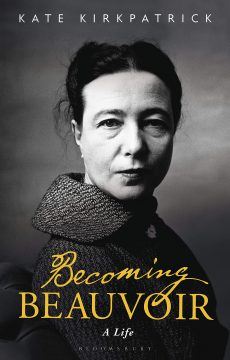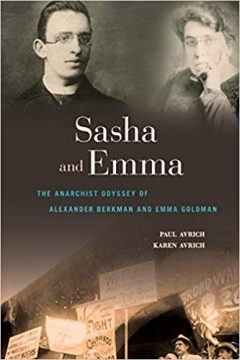by Adele A Wilby
 Biographies frequently provide us with insights into individual characters in a way that autobiographies might not: the third person narrator offers the prospect of greater ‘objectivity’ when evaluating and narrating information and events and circumstances. And so it is with Paul Avrich and Karen Avrich’s Sasha and Emma: The Anarchist Odyssey of Alexander Berkman and Emma Goldman,and Katie Kirkpatrick’s Becoming Beauvoir: A Life.These two books provide a wealth of knowledge on the political and philosophical thinking that engaged the brilliant minds of two significant women of the twentieth century: Emma Goldman and Simone Beauvoir.
Biographies frequently provide us with insights into individual characters in a way that autobiographies might not: the third person narrator offers the prospect of greater ‘objectivity’ when evaluating and narrating information and events and circumstances. And so it is with Paul Avrich and Karen Avrich’s Sasha and Emma: The Anarchist Odyssey of Alexander Berkman and Emma Goldman,and Katie Kirkpatrick’s Becoming Beauvoir: A Life.These two books provide a wealth of knowledge on the political and philosophical thinking that engaged the brilliant minds of two significant women of the twentieth century: Emma Goldman and Simone Beauvoir.
 The life trajectories of the two women could not have been more different: Goldman was a Jewish Russian émigré to the United States; she learned her politics through experience and in that process clarified her political thinking on anarchism, and her life was lived humbly. Beauvoir on the other hand, was from a bourgeois Catholic family and benefited from a formal education and she lived life relatively comfortably. However, despite their divergent lifestyles and politics, similarities can be drawn between their thinking on women, love and freedom.
The life trajectories of the two women could not have been more different: Goldman was a Jewish Russian émigré to the United States; she learned her politics through experience and in that process clarified her political thinking on anarchism, and her life was lived humbly. Beauvoir on the other hand, was from a bourgeois Catholic family and benefited from a formal education and she lived life relatively comfortably. However, despite their divergent lifestyles and politics, similarities can be drawn between their thinking on women, love and freedom.
There is literature available on these issues, but Goldman and Beauvoir were prepared to live the principles they espoused in the early twentieth century. For both women, freedom was central to their thinking and shaped the way they lived their lives. Consequently, their personal relationships were unconventional: they had many lovers and loves, including, in the case of Beauvoir, female lovers. Nevertheless, they were able to sustain a relationship with one man in particular throughout their lifetimes: Alexander Berkman in the case of Emma Goldman, and Jean Paul Sartre in the case of Simone de Beauvoir. Commenting on her first encounter with Berkman, Goldman says, ‘a deep love for him welled up in my heart… a feeling of certainty that our lives were linked for all time’. Beauvoir also identified something special in her meeting of Sartre: she was prepared to enter into a ‘pact’ with Sartre that was premised on a love for each other. The ‘pact’ would separate their relationship from ‘lesser’ lovers: their love would be what Sartre termed an ‘essential love’, and they were then free to pursue their open relationship unburdened of the constraints of monogamy and marriage.
However, as we learn from Avrich and Avrich and Kirkpatrick the sexual relationship between these enduring couples eventually came to an end.
Goldman acknowledges in her autobiography Living My Life that Berkman lost sexual interest in her, while according to Beauvoir, Sartre was ‘a warm, lively man everywhere, but not in bed’ and she failed to see any purpose in pursuing that aspect of her relationship with him. Neither women seemed troubled by the end of the physical relationship with these men: lovers were available, and so was love. Thus, what is it that held the relationship between these two couples together across time, and distance, and in the absence of a physical relationship?
Avrich and Avrich use the term ‘intense connection’ to describe the intertwined lives between Goldman and Berkman. Kirkpatrick, when pondering the relevance of Beauvoir’s life to modern times asks the question of the nature of the relationship between Beauvoir and Sartre when she says: ‘Was ‘the great love story of the century’ ultimately the story of a friendship?’
For sure these two historical relationships were complex. Of the two, Goldman’s enduring love for Berkman is remarkable: they were separated for the fourteen years he spent in prison, consequent to his involvement in an attempted assassination of a company owner, and yet there is no evidence that Goldman waned in her feelings and concern for Berkman. Throughout her autobiography, Living My Life, his well-being is a constant on her mind, and she missed his political companionship during his imprisonment; an issue that followed Goldman throughout her life, despite the many lovers that went in and out of her bed. Berkman too, caught up in his trials and tribulations could always rely on Goldman: they were there for each other, regardless of who else was in their lives.
Perhaps it was political expediency that kept Goldman and Berkman together. In a way, they grew together over the course of their political activism: no mean feat, in fact quite an extra-ordinary achievement given the vicissitudes of the politics to which they were exposed, and the contingency that such contexts create; neither rethought their ideals in such terms that led to divergence of their paths and separation. So, what was it that held these two political activists together?
Avrich and Avrich publish a letter from Goldman to Berkman on his sixty-fifth birthday, which testifies to their enduring love. Goldman writes: ‘true, I loved other men. But it is not an exaggeration when I say that no one ever was so rooted in my being, so ingrained in every fibre as you have been and are to this day. Men have come and gone in my long life. But you my dear will remain forever. I do not know why this should be so…I know that the only loss that would matter would be to lose you, or our friendship’. Deep love, indeed. Berkman replies to Goldman, ‘Naturally so, everything considered’.
If love was the gel that underpinned the survival of the relationship between Goldman and Berkman, what was the glue that kept Beauvoir and Sartre together. As Kirkpatrick’s book reveals, Beauvoir’s thinking and life was complex, but in a different way to that of Goldman’s life, perhaps attributable to the predominance of intellectual work over political activism in her life.
Beauvoir loved some of the men with whom she had a relationship, one being Nelson Algren, and indeed in that relationship she opted for her freedom rather than living with Algren as he wanted. While those relationships ran their course, the relationship with Sartre never did; the ‘pact’ agreed to in their younger years turned into a lifelong arrangement. But as Kirkpatrick shows, Beauvoir was an intellectual powerhouse equivalent to, if not greater, than Sartre, and they obviously enjoyed the sharing and exploring of philosophical ideas. Indeed, as Kirkpatrick reveals, Sartre never published without soliciting Beauvoir’s view of the text. It is within that context that Beauvoir describes Sartre as ‘the incomparable friend of her thought’.
It is impossible to underestimate the significance of such a reflection for a person of Beauvoir’s intellectual ability. Undoubtedly, she knew, or learned as she traversed her life, that while sex is readily available, it is also fleeting, and while love is a profound and joyous emotion, that too can be subject to the contingencies in life, but it is rare indeed to find an ‘incomparable friend of her thought’. This takes on even greater significance when we learn of the importance Beauvoir attributed to her mind. Beauvoir, at 78 years old, repeated a sentiment that followed her through life when she said, ‘the most important thing was my mind’. But both Beauvoir and Sartre conceded that there was something more special between them than intellectual compatibility, and we see this in their later years. With the progressive decline in Sartre’s health, Beauvoir ultimately became one of Sartre’s carers, and Sartre repeated his love for Beauvoir on his death bed. Kirkpatrick’s work leaves us to wonder if, in her relationship with Sartre, Beauvoir didn’t achieve what she had once wished for, ‘a love that accompanies me through life, not that absorbs all my life’.
Many would argue that in the absence of sexual relationship, Goldman and Berkman, and Beauvoir and Sartre were indeed just friends who loved each other. But as they moved through life there are indications that Goldman and Beauvoir, despite the openness of their relationships, were not totally ‘free’ from the emotions frequently attributed to feelings of love: jealousy. From Avrich and Avrich, we see that Goldman’s criticism of Berkman’s choice of a younger partner Emmy Eckstein, probably had more to do with jealousy, than her concern that Eckstein was not really appropriate for him. Indeed, Berkman hoped that the coolness in the relationship between the two women would not compel him to choose between them. Beauvoir too was concerned that some of Sartre’s relationships might be more than temporary.
In choosing to live the lives the way they did, both women, as their subsequent writings reveal, provide insightful understandings of women’s relationship to love, and freedom. In essence, these women chose freedom over the ‘security’ of marriage and the monogamy which underpins that institution. But in the final analysis, they really did have it all: rich fulfilling lives, lovers and love, and an enduring relationship.
Avrich and Avrich, and Kirkpatrick shed light into the nature of the relationships of these two extra-ordinary women: Emma Goldman and Simone de Beauvoir. It would be easy to attribute the enduring relationship between Goldman and Berkman as a consequence of mutual commitment to shared political objectives, and intellectual compatibility could be seen to be the driving force that bound Beauvoir and Sartre in a long-term relationship. Alternatively, they could be seen as lifelong friends. However, we also cannot dismiss the possibility that they were fortunate enough to love the Other unconditionally. In doing so, the desire to ‘possess’ the Other in the form of marriage as an expression of love, was not an impingement on their individual freedom, and did not come into play as a disturbing and disruptive factor in their enduring relationships. Perhaps they were living examples of how love really can mean freedom.
